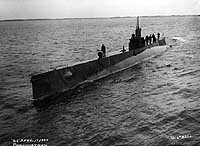![]() The Pacific War Online Encyclopedia
The Pacific War Online Encyclopedia
|
| Previous: S Class, British Destroyers | Table of Contents | Next: S-42 Class, U.S. Submarines |

Navy History and Heritage Command #41988
| Tonnage | 930 tons standard displacement surfaced 1094 tons displacement submerged |
| Dimensions | 219'3" by 20'6" by 15'1" 66.83m by 6.25m by 4.60m |
| Maximum speed | 13 knots surfaced 9 knots submerged |
| Maximum dive |
200 feet 61 meters |
| Complement | 50 |
| Armament | 4 21" torpedo
tubes (12 torpedoes) 1 4"/50 gun |
| Machinery |
2-shaft diesel (2000 bhp) or
electric (1200 hp) |
| Bunkerage | 64 tons diesel oil |
| Range | 3420 nautical miles 6300 km) at 6.5 knots surfaced (normal) 8950 nautical miles (16,580 km) at 9.5 knots with fuel in main ballast tanks 100 nautical miles (190 km) at 5 knots submerged |
| Cargo | 10 tons |
Prior to 1914, the U.S. Navy purchased submarines the way it purchased aircraft:
Specifications were issued, then complete designs were purchased from
manufacturers. However, the Navy was unhappy with this arrangement,
believing that this gave companies like Electric Boat too strong an
incentive to use their own patented devices aboard boats, rather than
the latest innovations. Submariners also felt that this gave Electric
Boat, which dominated early submarine construction, too much influence
over the role of submarines, with Electric Boat favoring the small
coastal defense submarine. Electric Boat did not hesitate to lobby
Congress directly for purchase of its designs, in which it was aided by
the fragmented responsibility for warship design within the Navy.
This began to change when Commander Emory Land, a construction officer who would later head the Maritime Commission,
was sent to sea with Atlantic submarines during the First World War.
The Navy wished to acquire its own independent submarine design
expertise, and Land came to share the submarine force's skepticism of
the coastal submarine and their enthusiasm for an 800-ton design
similar to that of the German
U-boats. In many respects these would resemble small fleet submarines,
a concept the Navy had been investigating since 1911. The fleet boat
was conceived as a fast, long-ranged boat, capable of keeping up with
battleships, that could take part in a fleet action.The Navy still lacked the experience with submarines to understand the
tradeoffs involved, particularly in surface speed versus submerged
speed: The spindle-form needed to optimize submerged speed was very
different from the ship-form required for good surface speed. Electric
Boat nonetheless proposed a plausible design in 1913, which eventually
became the T class
of 1919. These were unsuccessful, with numerous defects in their
machinery and relatively weak hulls. Designed before the lessons of wartime experience could be absorbed, the Ts were already obsolete when completed.
The S-1s, completed in 1920-1924, were the realization of the 800-ton concept. Three boats were originally authorized, to be designed independently by Electric Boat, Lake, and the Portsmouth Naval Yard. The General Board deliberately left the required characteristics as vague as possible to encourage design innovation, and as a result the design details varied considerably within the class.However, all featured larger torpedoes (21" or 53.3cm) and roomier conning towers than previous submarine designs. Putting anything close to fleet boat performance on an 800-ton displacement proved too great a challenge, and the General Board specified a reliable surface speed of just 14 knots. S-1 was completed by Electric Boat while S-2 and S-3 were the first Navy submarines completed in Navy shipyards. S-2 proved to be badly flawed and Electric Boat refused to build to the ambitious Navy design, so the wartime order of 60 S-boats most closely resembled Electric Boat's design. However, those listed separately as the S-42 class incorporated significant design improvements.
With their inadequate speed and range, the boats were not particularly successful in their envisioned role. However, a number of the Electric Boat units, which were considered the best of the class, were still in service when war broke out in the Pacific,and they found themselves deployed in a local patrol role. They were badly obsolete, lacking air conditioning for tropical duty, adequate heating for the Arctic, and modern fire control. Ironically, because they could not fire the defective torpedoes being built by the U.S. at the start of the war (since these submarines lacked an automatic target computer), they had a measure of success with older, simpler, and therefore more reliable torpedoes.
| S-18 | ||
| Grounded 17 June 1942 near Kiska at and scuttled |
||
| Lost 4 July 1944 off Oahu from unknown causes |
||
| S-36 | off Lingayen Gulf | Grounded 20 January 1942 off Makassar and scuttled |
| S-37 | Cavite | |
| S-38 | Mariveles | |
| S-39 | off southern Luzon | Grounded 14 August 1942 off
Rossel Island and scuttled |
| S-40 | Cavite | |
| S-41 | Cavite | |
| S-31 | Arrived 1942-5-21 | |
| S-32 | Arrived 1942-6 | |
| S-33 | Arrived 1942-6 | |
| S-30 | Arrived 1942-7-15 |
References
The Pacific War Online Encyclopedia © 2007-2008, 2011 by Kent G. Budge. Index